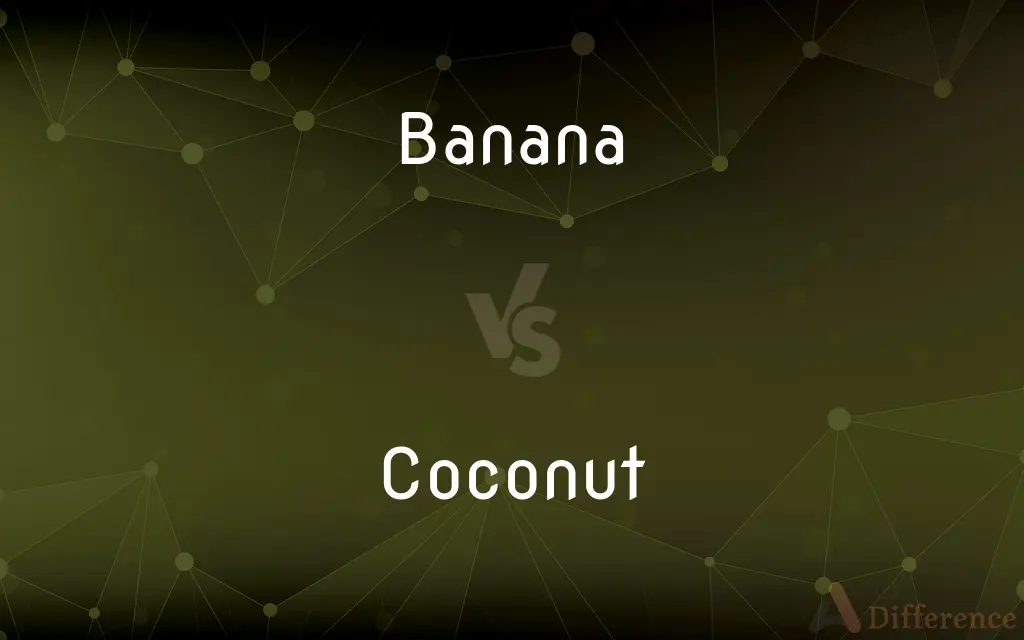Banana vs. Coconut — What's the Difference?
By Tayyaba Rehman & Fiza Rafique — Updated on March 21, 2024
Bananas are soft, sweet fruits from herbaceous plants, rich in potassium and vitamins, whereas coconuts are large, hard-shelled seeds from palm trees, offering water, milk, and oil.

Difference Between Banana and Coconut
Table of Contents
ADVERTISEMENT
Key Differences
Bananas are characterized by their elongated shape, yellow peel, and soft, sweet flesh, originating from large herbaceous flowering plants. Coconuts, on the other hand, come from coconut palm trees and consist of a hard exterior, fibrous husk, and a nutritious inner layer that includes coconut water and meat.
Nutritionally, bananas are known for their high potassium content and also provide a good source of dietary fiber, vitamin C, and vitamin B6. Coconuts provide a different set of nutritional benefits, including high amounts of medium-chain triglycerides (MCTs), which are fats that can aid in metabolism, and are also rich in manganese, which is essential for bone health and metabolism.
Culinary uses of bananas vary from eating them raw as a snack to incorporating them into desserts, smoothies, and baked goods. Coconuts are more versatile in cooking and are used in a wide range of culinary contexts, from the water being a refreshing drink to the milk and oil being used in cooking and baking for their rich flavors and textures.
In terms of cultivation, bananas grow in clusters at the top of the plant, requiring warm, tropical climates to flourish. Coconuts also thrive in tropical conditions but grow individually on tall palm trees and can take several years to mature and produce fruit.
Environmental impact considerations show that banana cultivation can lead to deforestation and the use of pesticides, affecting local ecosystems. Coconut production has its concerns, particularly in the form of habitat destruction and the exploitation of labor in some producing regions.
ADVERTISEMENT
Comparison Chart
Origin
Herbaceous plants
Palm trees
Nutritional Highlights
High in potassium, vitamins C and B6
Rich in MCTs, manganese
Culinary Uses
Raw, desserts, smoothies
Water, milk, oil in cooking
Cultivation
Clusters on plants, tropical climates
Tall palm trees, takes years to mature
Environmental Impact
Deforestation, pesticide use
Habitat destruction, labor concerns
Compare with Definitions
Banana
Grown in tropical climates.
Bananas are cultivated extensively in Ecuador and Colombia.
Coconut
Cultivated in tropical regions.
The Philippines is a leading producer of coconuts.
Banana
A soft, sweet fruit.
She added a banana to her morning smoothie for extra sweetness.
Coconut
A large, hard-shelled seed.
Coconuts are harvested for their water, milk, and flesh.
Banana
Prone to pests and diseases.
Banana plants are often threatened by the fungus known as Panama disease.
Coconut
Used in a variety of dishes.
Coconut milk adds a rich flavor to curries and soups.
Banana
High in potassium.
Eating a banana a day can help maintain normal blood pressure.
Coconut
High in medium-chain triglycerides.
Coconut oil contains fats that may support metabolism.
Banana
Eaten raw or cooked.
Bananas can be baked into bread for a delicious treat.
Coconut
Provides water and oil.
Coconut oil is used for cooking and in cosmetic products.
Banana
A banana is an elongated, edible fruit – botanically a berry – produced by several kinds of large herbaceous flowering plants in the genus Musa. In some countries, bananas used for cooking may be called "plantains", distinguishing them from dessert bananas.
Coconut
The coconut tree (Cocos nucifera) is a member of the palm tree family (Arecaceae) and the only living species of the genus Cocos. The term "coconut" (or the archaic "cocoanut") can refer to the whole coconut palm, the seed, or the fruit, which botanically is a drupe, not a nut.
Banana
Any of several treelike plants of the genus Musa, especially M. acuminata, having a terminal crown of large, entire leaves and a hanging cluster of fruits.
Coconut
The fruit of the coconut palm, consisting of a fibrous husk surrounding a large seed.
Banana
The elongated, edible fruit of these plants, having a thick yellowish to reddish skin and whitish, pulpy flesh.
Coconut
The large, brown, hard-shelled seed of the coconut, containing white flesh surrounding a partially fluid-filled central cavity.
Banana
An elongated curved tropical fruit of a banana plant, which grows in bunches and has a creamy flesh and a smooth skin.
Coconut
The edible white flesh of the coconut, often shredded and used in food and confections or for the extraction of coconut oil.
Banana
In particular, the sweet, yellow fruit of the Cavendish banana cultivar, which may be eaten raw, as distinct from e.g. a plantain for cooking.
Coconut
A coconut palm.
Banana
The tropical tree-like plant which bears clusters of bananas, a plant of the genus Musa (but sometimes also including plants from Ensete), which has large, elongated leaves.
Coconut
A fruit of the coconut palm (not a true nut), Cocos nucifera, having a fibrous husk surrounding a large seed.
Banana
(uncountable) A yellow colour, like that of a banana's skin.
Coconut
A hard-shelled seed of this fruit, having white flesh and a fluid-filled central cavity.
Banana
A person of East Asian descent, especially an ethnic Chinese from a Western country who does not speak Chinese and only speaks English, considered to have overly assimilated and to be subservient to white authority, an East Asian race traitor.
Coconut
(uncountable) The edible white flesh of this fruit.
Banana
(sports) A banana kick.
Coconut
The coconut palm.
Banana
(nuclear physics) A banana equivalent dose.
Coconut
A Hispanic or other dark-skinned person considered to have overly assimilated to white culture, a race traitor.
Banana
A catamorphism (from the use of banana brackets in the notation).
Coconut
A black person considered to have overly assimilated to white culture, a black race traitor.
Banana
Curved like a banana, especially of a ball in flight.
Coconut
A Pacific islander.
Banana
A perennial herbaceous plant of almost treelike size (Musa sapientum); also, its edible fruit. See Musa.
Coconut
(slang) The human head.
Banana
Any of several tropical and subtropical treelike herbs of the genus Musa having a terminal crown of large entire leaves and usually bearing hanging clusters of elongated fruits
Coconut
The edible white meat of a coconut{3}; often shredded for use in e.g. cakes and curries.
Banana
Elongated crescent-shaped yellow fruit with soft sweet flesh
Coconut
The cocoa palm.
Coconut
The large, hard-shelled oval nut of the cocoa palm. It has a fibrous husk containing a thick white fibrous meat much used as food, in confections, and in making oil. It has a central cavity filled (when fresh) with an agreeable milky liquid.
Coconut
The edible white meat a coconut; often shredded for use in e.g. cakes and curries
Coconut
Large hard-shelled oval nut with a fibrous husk containing thick white meat surrounding a central cavity filled (when fresh) with fluid or milk
Coconut
Tall palm tree bearing coconuts as fruits; widely planted throughout the tropics
Common Curiosities
How do the culinary uses of bananas and coconuts differ?
Bananas are often eaten raw or used in sweet dishes, whereas coconuts provide water, milk, and oil for various culinary uses.
Can coconuts be eaten raw?
Yes, both the water and the meat of coconuts can be consumed raw.
Are bananas and coconuts grown in the same climate?
Both require warm, tropical climates to grow but are cultivated on different types of plants.
How are bananas and coconuts different in terms of plant type?
Bananas grow on large herbaceous plants, while coconuts grow on tall palm trees.
What are some environmental concerns with coconut cultivation?
It can involve habitat destruction and has faced issues with labor exploitation.
What is the primary nutritional benefit of bananas?
Bananas are particularly noted for their high potassium content.
What is the significance of manganese in coconuts?
Manganese plays a crucial role in bone health and metabolism, and coconuts are a rich source.
What are the environmental concerns associated with banana cultivation?
Banana cultivation can lead to deforestation and requires significant pesticide use.
What makes coconut oil unique?
Coconut oil contains medium-chain triglycerides, which are beneficial fats that support metabolism.
What are some common uses for bananas in cooking?
Bananas are used in smoothies, desserts, and baked goods for their sweetness.
How does the cultivation of bananas and coconuts impact local ecosystems?
Both can have negative impacts, including habitat destruction, pesticide use, and labor concerns, affecting biodiversity and local communities.
How do bananas contribute to a healthy diet?
They provide essential vitamins and fiber, supporting heart health and digestion.
Why is coconut water popular?
It's a natural, hydrating drink rich in electrolytes, making it a popular choice for hydration.
Can banana plants be affected by diseases?
Yes, banana plants are susceptible to diseases like Panama disease, which affects their production.
How long does it take for a coconut tree to produce fruit?
Coconut trees can take several years to mature and start producing fruit.
Share Your Discovery

Previous Comparison
Contingent vs. Predicate
Next Comparison
Tinker vs. GypsyAuthor Spotlight
Written by
Tayyaba RehmanTayyaba Rehman is a distinguished writer, currently serving as a primary contributor to askdifference.com. As a researcher in semantics and etymology, Tayyaba's passion for the complexity of languages and their distinctions has found a perfect home on the platform. Tayyaba delves into the intricacies of language, distinguishing between commonly confused words and phrases, thereby providing clarity for readers worldwide.
Co-written by
Fiza RafiqueFiza Rafique is a skilled content writer at AskDifference.com, where she meticulously refines and enhances written pieces. Drawing from her vast editorial expertise, Fiza ensures clarity, accuracy, and precision in every article. Passionate about language, she continually seeks to elevate the quality of content for readers worldwide.














































